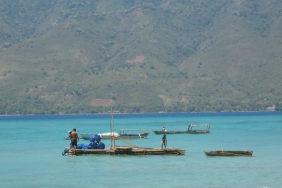#XPDCKEIKECIL: 'METI KEI' PHENOMENON
By: Ayu Ginanjar Syukur (Responsible Marine Tourism Staff, WWF-Indonesia)
The highlights of the first and second day dives for team B were the 'Meti Kei' phenomenon which meant we had to leave on time, return to the lodge for a slightly longer lunch break, and the boat also had to be careful not to get caught between the reefs.
What exactly is 'Meti Kei'?
The 'Meti Kei' phenomenon is the lowest low tide of the year. "'Meti Kei' has become a common term in Eastern Indonesia. In fact, the biggest low tide occurs in Aru. But because people in Kei popularized the term first, it is called 'Meti Kei', not 'Meti Aru'. In fact, because it is so well known, this term is also used to describe financial conditions that are running low," said Om Noke.
'Meti Kei' takes place in Kei waters for approximately two months per year, October-November. During 'Meti Kei' - which generally occurs for a few hours a day - many things catch my eye. These range from the coastal area increasing by 500-700m seaward; several islands being connected due to the receding tide; intertidal communities receding to take marine and coastal resources; to the appearance of mounds of coral reefs on the surface, such as those on Ohoiwa Island and Tetoat Village.
As a coral reef researcher, my first impression is that the emergence of coral reef mounds above the surface is very interesting, because we do not need to go under the sea to see coral reefs. Although it looks beautiful from above the sea, coral reefs exposed to sunlight have both positive and negative impacts. "The advantage of corals that are often exposed to sunlight is that they become more resistant or strong to environmental changes compared to corals that receive little light. So, if there is a change in sea surface temperature due to global warming, corals that are often exposed are accustomed to it and do not die easily. Meanwhile, the most visible negative impact is that some coral reefs are already stressed by showing signs of bleaching. In addition, corals become more easily broken because humans can walk on them," said Iqbal. "Therefore, if an area experiences 'Meti Kei', then the area should be more closely monitored so that human activities do not add pressure to the exposed coral reef ecosystem," he continued.
We were very lucky to have been informed in advance by the local community about the timing of the 'Meti Kei', so that we did not have to push the boat, and of course, neither we nor the boat needed to damage the reef to reach the shore.




